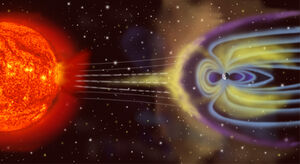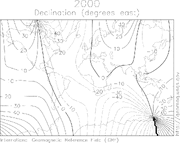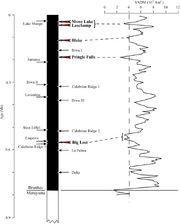No edit summary |
No edit summary |
||
| (2 intermediate revisions by 2 users not shown) | |||
| Line 1: | Line 1: | ||
| − | {{ |
+ | {{Biopsy}} |
| + | {{PsyPerspective}} |
||
| ⚫ | |||
| + | |||
| ⚫ | '''Earth's magnetic field''' (and the '''surface magnetic field''') is approximately a |
||
| ⚫ | |||
| ⚫ | '''Geomagnetism''' arises from the '''Earth's magnetic field''' (and the '''surface magnetic field''') is approximately a magnetic dipole, with one magnetic pole near the north pole and the other near the geographic south pole. An imaginary line joining the magnetic poles would be inclined by approximately 11.3° from the planet's axis of rotation. The cause of the field is probably explained by [[dynamo theory]]. The magnetic field extends several tens of thousands of [[kilometre]]s into [[outer space|space]] as the [[magnetosphere]]. |
||
==Magnetic poles== |
==Magnetic poles== |
||
| Line 10: | Line 12: | ||
The Earth's field is changing in size and position. The two poles wander independently of each other and are not at directly opposite positions on the globe. Currently the south magnetic pole is farther from the geographic south pole than the north magnetic pole is from the north geographic pole. |
The Earth's field is changing in size and position. The two poles wander independently of each other and are not at directly opposite positions on the globe. Currently the south magnetic pole is farther from the geographic south pole than the north magnetic pole is from the north geographic pole. |
||
| + | |||
| − | '''Magnetic pole positions''' |
||
| − | {| border=1 cellpadding=5 align=center |
||
| − | |- |
||
| − | |North Magnetic Pole <ref>[http://gsc.nrcan.gc.ca/geomag/nmp/northpole_e.php Geomagnetism, North Magnetic Pole]. Natural Resources Canada, 2005-03-13.</ref>||(2001) {{Coor d|81.3|N|110.8|W|}}||(2004 est) {{Coor d|82.3|N|113.4|W|}} || (2005 est) {{Coor d|82.7|N|114.4|W|}} |
||
| − | |- |
||
| − | |South Magnetic Pole <ref>[http://www.antdiv.gov.au/default.asp?casid=1843 South Magnetic Pole]. Commonwealth of Australia, Australian Antarctic Division, 2002.</ref>||(1998) {{Coor d|64.6|S|138.5|E|}}.||(2004 est) {{Coor d|63.5|S|138.0|E|}} || |
||
| − | |} |
||
==Field characteristics== |
==Field characteristics== |
||
| − | The field is similar to that of a bar [[magnet]], but this similarity is superficial. The magnetic field of a bar magnet, or any other type of permanent magnet, is created by the coordinated motions of [[electron]]s (negatively charged particles) within [[iron]] [[atom]]s. The Earth's core, however, is hotter than 1043 |
+ | The field is similar to that of a bar [[magnet]], but this similarity is superficial. The magnetic field of a bar magnet, or any other type of permanent magnet, is created by the coordinated motions of [[electron]]s (negatively charged particles) within [[iron]] [[atom]]s. The Earth's core, however, is hotter than 1043 kelvin, the Curie point temperature at which the orientations of electron orbits within iron become randomized. Such randomization tends to cause the substance to lose its magnetic field. Therefore the Earth's magnetic field is caused not by magnetised iron deposits, but mostly by [[electric current]]s in the liquid outer core. |
| − | Another feature that distinguishes the Earth magnetically from a bar magnet is its |
+ | Another feature that distinguishes the Earth magnetically from a bar magnet is its magnetosphere. At large distances from the planet, this dominates the surface magnetic field. Electric currents induced in the ionosphere also generate magnetic fields. Such a field is always generated near where the atmosphere is closest to the Sun, causing daily alterations which can deflect surface magnetic fields by as much as one degree. |
==Magnetic field variations== |
==Magnetic field variations== |
||
| Line 30: | Line 26: | ||
[[Magnetometer]]s detect minute deviations in the Earth's magnetic field caused by iron artifacts, kilns, some types of stone structures, and even ditches and middens in [[geophysical survey]]. Using the magnetic instruments adapted from airborne devices developed during World War II to detect submarines, the magnetic variations across the ocean floor have been mapped. The basalt -- the iron-rich, volcanic rock making up the ocean floor -- contains a strongly magnetic mineral (magnetite) and can locally distort compass readings. The distortion was recognized by Icelandic mariners as early as the late 18th century. More important, because the presence of magnetite gives the basalt measurable magnetic properties, these magnetic variations have provided another means to study the deep ocean floor. When newly formed rock cools, such magnetic materials record the Earth's magnetic field. |
[[Magnetometer]]s detect minute deviations in the Earth's magnetic field caused by iron artifacts, kilns, some types of stone structures, and even ditches and middens in [[geophysical survey]]. Using the magnetic instruments adapted from airborne devices developed during World War II to detect submarines, the magnetic variations across the ocean floor have been mapped. The basalt -- the iron-rich, volcanic rock making up the ocean floor -- contains a strongly magnetic mineral (magnetite) and can locally distort compass readings. The distortion was recognized by Icelandic mariners as early as the late 18th century. More important, because the presence of magnetite gives the basalt measurable magnetic properties, these magnetic variations have provided another means to study the deep ocean floor. When newly formed rock cools, such magnetic materials record the Earth's magnetic field. |
||
| − | In [[October 2003]], the Earth's magnetosphere was hit by a solar flare causing a brief but intense geomagnetic storm, provoking unusual displays of [[aurorae]]. |
||
| − | ==Magnetic field reversals== |
||
| − | {{main|geomagnetic reversal}} |
||
| − | |||
| − | Based upon the study of lava formations in [[Hawaii]], it has been deduced that the Earth's magnetic field reverses at intervals, ranging from tens of thousands to many millions of [[year]]s, with an average interval of approximately 250,000 years. The last such event, called the [[Brunhes-Matuyama reversal]], occurred some 780,000 years ago. |
||
| − | |||
| − | The mechanism responsible for geomagnetic reversals is not well understood. Some scientists have produced models for the core of the Earth wherein the magnetic field is only quasi-stable and the poles can spontaneously migrate from one orientation to the other over the course of a few hundred to a few thousand years. Other scientists propose that the geodynamo first turns itself off, either spontaneously or through some external action like a comet [[impact event|impact]], and then restarts itself with the magnetic "North" pole pointing either North or South. External events are not likely to be routine causes of magnetic field reversals due to the lack of a correlation between the age of impact craters and the timing of reversals. Regardless of the cause, when magnetic "North" reappears in the opposite direction this is a reversal, whereas turning off and returning in the same direction is called a [[geomagnetic excursion]]. |
||
| − | |||
| − | Using a magnetic detector (a variant of a compass), scientists have measured the historical direction of the Earth's magnetic field, by studying the layered iron-rich lava rocks. This is possible as each layer has been found to maintain the original magnetic field at its time of cooling. They have found that the poles have shifted a number of times throughout the past. |
||
==Magnetic field decay== |
==Magnetic field decay== |
||
The earth's magnetic field strength was measured by [[Carl Friedrich Gauss]] in [[1835]] and has been repeatedly measured since then, showing an exponential decay with a half-life of about 1400 years. This could also be stated as a relative decay of about 10% to 15% over the last 150 years. |
The earth's magnetic field strength was measured by [[Carl Friedrich Gauss]] in [[1835]] and has been repeatedly measured since then, showing an exponential decay with a half-life of about 1400 years. This could also be stated as a relative decay of about 10% to 15% over the last 150 years. |
||
| − | |||
| − | ==Magnetic field electrogenerators== |
||
| − | Some [[free energy|free-energy]] enthusiasts claim that the Earth's magnetic field could be used to generate power<ref>C. L. Stong, "''[http://scholar.google.com/url?sa=U&q=http://www.meridian-int-res.com/Energy/ESMotors.pdf Electrostatic motors are powered by electric field of the Earth]''". October, 1974. (PDF)</ref>, but such claims are regarded as [[pseudoscience]] by many skeptics. Many designs for using the Earth's electromagnetic field and [[atmospheric electricity]] have been researched, but have failed to gain any widespread acknowledgement in the scientific community. There is also some energy stored in the form of separated electrical charges, which can provide low direct currents at high voltages. However, ordinary electric motors cannot use this energy directly as a prime mover. [[Benjamin Franklin]] developed several motors that used the Earth's fields. [[Oleg D. Jefimenko]] has researched several machine designs for tapping the Earth's electromagnetic field. |
||
| − | |||
| − | The Earth's magnetic field can be used as the starting field for a self-excited electric generator. [[Cromwell Varley]] discovered in 1867 that an electric generator did not need to be started with a conventional prime mover. He used the Earth's magnetic field to induce enough field strength in the stator windings to get a generator running. <ref>Bunch, Bryan, and Alexander Hellemans, "The History of Science and Technology: A Browser's Guide to the Great Discoveries, Inventions, and the People Who Made Them from the Dawn of Time to Today". ISBN 0618221239</ref> |
||
| − | |||
| − | [[Electrodynamic tether]]s can induce a current by moving through the planet's magnetic field. When the conductive tether is trailed in a planetary or solar magnetosphere (magnetic field), the tether cuts the field, generates a current, and thereby slows the spacecraft into a lower orbit. The tether's end can be left bare, and this is sufficient to make contact with the ionosphere and allow a current to flow through a [[phantom loop]]. A cathode tube may also be placed at the end of the tether. The cathode tube will interact with the planet's magnetic field in the vacuum of space. A double-ended cathode tube tether will allow alternating currents. |
||
| − | |||
| − | : Main article: ''[[The detection of the earths magnetic field by animals and man]]'' |
||
| − | ==References and further readings== |
||
| + | ==References== |
||
| − | ;''General'' |
||
| − | * ''[[Discovering the Essential Universe]]'' by [[Neil F. Comins]] ([[2001]]) |
||
| − | * ''[[Introduction to Geomagnetically Trapped Radiation]]'' by [[Martin Walt]] ([[1994]]) |
||
| − | ;''Field characteristics'' |
||
| − | * ''[http://www.newton.dep.anl.gov/askasci/gen99/gen99256.htm Temperature of the Earth's core]'', US Dept of Energy. |
||
| − | ;''Citations'' |
||
| − | <references /> |
||
| − | ;Further readings |
||
| − | * [[James R. Wait|Wait, J.R.]], "''[http://scitation.aip.org/getabs/servlet/GetabsServlet?prog=normal&id=GPYSA7000019000002000281000001&idtype=cvips&gifs=yes On the relation between telluric currents and the earth’s magnetic field]''", Geophysics, 19, 281-289, 1954. |
||
| − | * Towle, J. N.,"''The Anomalous Geomagnetic Variation Field and Geoelectric Structure Associated with the Mesa Butte Fault System, Arizona''". Geological Society of America, Bulletin, 95:221, 1984. |
||
==See also== |
==See also== |
||
| − | *[[ |
+ | * [[Magnetism]] |
| − | * [[Earth radiation]] |
||
| − | * [[Earth battery]] |
||
| − | * [[Van Allen radiation belt]] |
||
==External links == |
==External links == |
||
Latest revision as of 11:15, 24 April 2008
Assessment |
Biopsychology |
Comparative |
Cognitive |
Developmental |
Language |
Individual differences |
Personality |
Philosophy |
Social |
Methods |
Statistics |
Clinical |
Educational |
Industrial |
Professional items |
World psychology |
Biological: Behavioural genetics · Evolutionary psychology · Neuroanatomy · Neurochemistry · Neuroendocrinology · Neuroscience · Psychoneuroimmunology · Physiological Psychology · Psychopharmacology (Index, Outline)

The magnetosphere shields the surface of the Earth from the charged particles of the solar wind. It is compressed on the day (Sun) side due to the force of the arriving particles, and extended on the night side.
Geomagnetism arises from the Earth's magnetic field (and the surface magnetic field) is approximately a magnetic dipole, with one magnetic pole near the north pole and the other near the geographic south pole. An imaginary line joining the magnetic poles would be inclined by approximately 11.3° from the planet's axis of rotation. The cause of the field is probably explained by dynamo theory. The magnetic field extends several tens of thousands of kilometres into space as the magnetosphere.
Magnetic poles

Magnetic declination from true north in 2000.
The locations of the magnetic poles are not static but wander as much as 15km every year (Dr. David P. Stern, emeritus Goddard Space Flight Center, NASA). The pole position is usually not that indicated on many charts and many magnetic pole marking brings a confusion as to what is being located at the given positions. The Geomagnetic Pole positions are usually not close to the position that commercial cartographers place "Magnetic Poles." "Geomagnetic Dipole Poles", "IGRF Model Dip Poles", and "Magnetic Dip Poles" are variously used to denote the magnetic poles. [1]
The Earth's field is changing in size and position. The two poles wander independently of each other and are not at directly opposite positions on the globe. Currently the south magnetic pole is farther from the geographic south pole than the north magnetic pole is from the north geographic pole.
Field characteristics
The field is similar to that of a bar magnet, but this similarity is superficial. The magnetic field of a bar magnet, or any other type of permanent magnet, is created by the coordinated motions of electrons (negatively charged particles) within iron atoms. The Earth's core, however, is hotter than 1043 kelvin, the Curie point temperature at which the orientations of electron orbits within iron become randomized. Such randomization tends to cause the substance to lose its magnetic field. Therefore the Earth's magnetic field is caused not by magnetised iron deposits, but mostly by electric currents in the liquid outer core.
Another feature that distinguishes the Earth magnetically from a bar magnet is its magnetosphere. At large distances from the planet, this dominates the surface magnetic field. Electric currents induced in the ionosphere also generate magnetic fields. Such a field is always generated near where the atmosphere is closest to the Sun, causing daily alterations which can deflect surface magnetic fields by as much as one degree.
Magnetic field variations

Geomagnetic variations since last reversal.
The strength of the field at the Earth's surface ranges from less than 30 microteslas (0.3 gauss) in an area including most of South America and South Africa to over 60 microteslas (0.6 gauss) around the magnetic poles in northern Canada and south of Australia, and in part of Siberia.
Magnetometers detect minute deviations in the Earth's magnetic field caused by iron artifacts, kilns, some types of stone structures, and even ditches and middens in geophysical survey. Using the magnetic instruments adapted from airborne devices developed during World War II to detect submarines, the magnetic variations across the ocean floor have been mapped. The basalt -- the iron-rich, volcanic rock making up the ocean floor -- contains a strongly magnetic mineral (magnetite) and can locally distort compass readings. The distortion was recognized by Icelandic mariners as early as the late 18th century. More important, because the presence of magnetite gives the basalt measurable magnetic properties, these magnetic variations have provided another means to study the deep ocean floor. When newly formed rock cools, such magnetic materials record the Earth's magnetic field.
Magnetic field decay
The earth's magnetic field strength was measured by Carl Friedrich Gauss in 1835 and has been repeatedly measured since then, showing an exponential decay with a half-life of about 1400 years. This could also be stated as a relative decay of about 10% to 15% over the last 150 years.
References
See also
External links
- "The Great Magnet, the Earth" A history of geomagnetism (20+ sections), marking the 400th anniversary of "De Magnete" by William Gilbert (reviewed). Also covers early magnetic surveys, dynamo theory, the Sun's magnetic effects, geomagnetic reversals, and magnetospheres of Earth and planets. With timeline, glossary, historical review article (cited below), Q&As and translations to Spanish, German and French.
- USGS Geomagnetism Program. Real time monitoring of the Earth's magnetic field. U.S. Department of the Interior, U.S. Geological Survey, February 17, 2005.
- Geomagnetism. National Geophysical Data Center, NOAA. Apr-2005.
- BGS Geomagnetism. Information on monitoring and modelling the geomagnetic field. British Geological Survey, August 2005.
- A Millennium of Geomagnetism, a history of geomagnetism, with many scientific references.
- William J. Broad, "Will Compasses Point South?". New York Times, July 13, 2004.
- John Roach, "Why Does Earth's Magnetic Field Flip?". National Geographic, September 27, 2004.
- "Magnetic Storm". PBS NOVA, 2003. (ed. about pole reversals)
- "When North Goes South". Projects in Scientific Computing, 1996.
ar:مغنطيسية أرضية de:Erdmagnetfeld es:Campo magnético terrestre fr:Champ magnétique terrestre gl:Campo magnético terrestre nl:Aardmagnetisch veld pt:Campo magnético terrestre fi:Maan magneettikenttä zh:地磁场
- ↑ "Problem with the "MAGNETIC" Pole Locations on Global Charts". Eos Vol. 77, No. 36, American Geophysical Union, 1996.